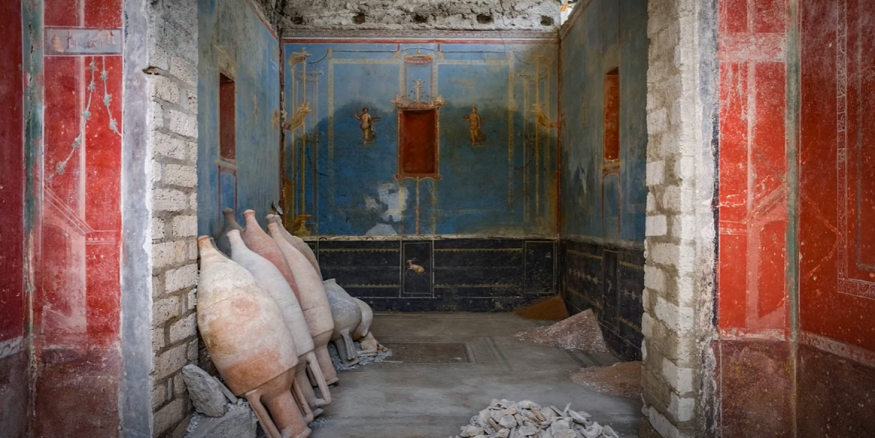In Pompeii, Italy, archaeologists have uncovered a unique "blue room" adorned with ancient Roman murals. This discovery was announced earlier this month at the Archaeological Parks of Pompeii.
Found within the central area of the historic city, the room, measuring about 90 square feet, was first identified during the Bourbon period between 1813 and 1840 but has only recently been fully excavated. The grand reveal of the room took place on May 27, showing its vibrant cerulean-painted walls for the first time in centuries.

Pompeii Discovery Unveils Ancient Roman Secrets
The room's frescoes are significant both artistically and culturally. Some murals depict the four seasons, known as "Horea," while others feature symbols of agriculture, such as a plow and a "pedum," a short staff traditionally used by shepherds and hunters.
According to ABC News, the use of blue pigment in the room is particularly noteworthy; this color is rarely found in Pompeian frescoes and is typically reserved for more elaborately decorated spaces.
This suggests the room held considerable importance, likely serving as a sacrarium-a sanctuary devoted to ritual activities and the storage of sacred objects.
During the excavation, archaeologists also discovered various artifacts inside the room, including 15 transport amphorae, which are large vases, and a collection of bronze items consisting of two jugs and two lamps.
Additionally, they found piles of building materials intended for renovation and a heap of empty oyster shells.
This excavation is part of a broader initiative to protect the extensive heritage of Pompeii, which encompasses 1070 residential units with around 13,000 rooms, along with numerous public and sacred spaces.
As of now, it remains unclear whether the blue room is open to the public.
Child Sketches Unveil Pompeii's Violent Past

Archaeologists in Pompeii have made a poignant discovery-charcoal sketches believed to have been drawn by children, depicting scenes of violence that they might have witnessed.
As per the Independent, these sketches include figures of gladiators and were found on the walls of a structure known as the "Colonnaded Cenacle."
The drawings also featured small handprints and other playful scenes such as children playing with a ball and a hunting scene, which suggests these were the works of children around six or seven years old.
According to Gabriel Zuchtriegel, the director of the Pompeii site, these drawings provide knowledge into the daily lives and even the psychological experiences of young residents in the ancient city.
Experts, including psychologists from the Federico II University in Naples, suggest that these images could represent real events the children saw, rather than creations of their imagination.
In a related discovery at the site, a unique banquet hall with elegant black walls and a mosaic floor was recently uncovered.
The walls were adorned with paintings of mythological figures like Helen of Troy and Apollo, intended to captivate and initiate conversation among guests.
This banquet hall, found near the southern Italian city of Naples, was part of a larger project aimed at strengthening the boundary between excavated and yet-to-be-explored areas of Pompeii.
This article is copyrighted by Travelers Today, the travel news leader




